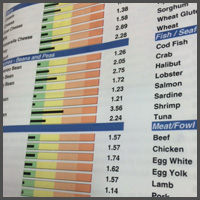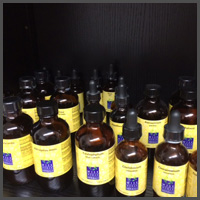 Food allergy/sensitivity testing
Food allergy/sensitivity testing
Food allergies or sensitivities are not always as overt as one might think. There is more than just the anaphylactic (IgE) lip swelling, throat closing off reaction that we associate with peanut allergies. Patients may be experiencing a delayed sensitivity (IgG) reaction that causes inflammation in the body one to several days later. Sometimes it is very hard to determine what all has been consumed over a period of days and frequently patients that already eat a healthy diet find that one or more healthy foods are not a good choice for their body; in these cases food sensitivity testing is utilized to determine which foods may be creating unwanted inflammation in the body. The test is done with a quick blood draw or finger prick and sent to the lab for analysis, giving results of over 90+ different food items and how they react in your body. Insurances typically do not cover this type of testing.
 Biotherapeutic drainage
Biotherapeutic drainage
Biotherapeutic drainage is a system of medicine based that helps the body more effectively drain toxins/waste to restore it to normal physiological function. It typically uses a series of 3 homeopathic solutions and some lifestyle modifications aimed at the draining of toxic/waste buildup in tissues, eliminating that waste from the body and then restoring the tissue to normal function. This can be an effective tool for all body systems and conditions; it can be especially useful for those that have had specific exposures to toxins and/or have been living in heavily polluted areas for a period of time.
Here are a couple examples:
- Example 1: Hypothyroidism: a patient presents with hypothyroidism (or low functioning thyroid and sluggish metabolism) for which the patient is taking medications to provide the body with the hormones that the thyroid gland is not making. The patient is started on this form of gentle detox by taking a series of drops specific to draining the thyroid tissues, helping the waste exist the body (through normal detox pathways of breath, urine, stool and sweat) and restoring the gland to its normal functioning state. Within a period of time, the patient can reduce or eliminate medications while the gland begins to return to optimal function.
- Example 2: Fibroids: a patient presents with numerous fibroids of various sizes, she been recommended to have a surgery to remove the fibroids or the whole uterus. The patient would like to preserve fertility and avoid surgeries, so we prescribe some drops to help drain the uterine tissue along with some basic dietary modifications. Within a few months, follow up ultrasound has shown over a centimeter reduction in the fibroids.
- Example 3: Asthma: draining/detoxing the lung fields and restoring them normal physiology can reduce the need for inhalers, keep airways open and eliminate symptoms of allergies.
 Homeopathy
Homeopathy
Homeopathy is a system of medicine based on physics that works on rebalancing the body to its healthy state. Often when the word homeopathy is presented as part of a treatment plan, it is met with a “I’ve heard of that, but I don’t really know what it is.” In attempt to simplify a more complex physics concept, here is an example: let’s say a patient comes in with the chief concern of insomnia. They have the particular type of insomnia that presents with jitteriness, overstimulation/anxiety and inability to relax to sleep. Based on those symptoms and the patient’s personality, they are best re-balanced by a homeopathic remedy called coffea cruda, which is latin for coffee. What happens when someone over-consumes coffee? The same symptoms of jitteriness, overstimulation/anxiety, etc. The coffee bean is then mashed up and brought through many dilutions until there is no longer a measurable amount of coffee in the solution. For you physics people, at this point the solution carries the “wavelength of coffee” which is then dosed to the patient to trigger the body to return to homeostasis.
There are hundreds of different homeopathic remedies that can treat maladies from sleep disorders, indigestion, mental/emotional states, aches/pains, etc.
 Diet and Nutrition
Diet and Nutrition
“We are what we eat…” and thus should be considerate of what goes into our bodies. As part of a treatment plan, minor to major dietary modifications may be recommended. It is not expected that a patient overhaul their entire diet overnight. Often times the addition of a food or two into the patient’s normal eating schedule can assist the body in its healing process.
 Botanical Medicine
Botanical Medicine
Botanical or herbal medicine comes directly from mother nature in plant form and has been used throughout history to treat various ailments in the body. Many of today’s pharmaceutical drugs come from plants. Botanical medicine can come in many different forms: teas, powders, capsules, tinctures and “whole plant” preparations (ex: consuming flax seeds or blueberries for their medicinal properties). Of note, tinctures are alcohol extracts of herbs, they are highly effective, but can taste poorly – frequently herbal dosing can be modified to the palate of the individual.
 Basic labs
Basic labs
Most medical providers recommend screening bloodwork every 1-5 years over the age of 20 in absence of disease. Basic blood work allows us to look for things like infection, anemia, high cholesterol, diabetes, liver and kidney disease, amongst other conditions.

